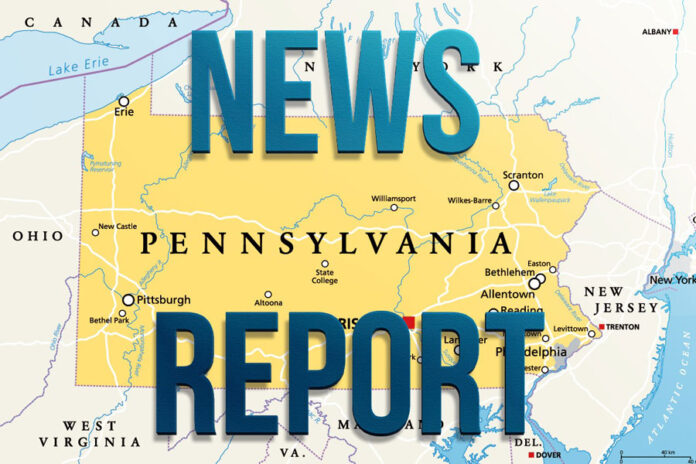PennLive. May 18, 2024
Editorial: Racism in fire departments endangers the entire community
At a time when fire departments are desperately trying to recruit young people into their ranks, Swatara Township has shuttered a volunteer fire house due to what authorities say are credible reports of racial discrimination.
At a time when fire departments are desperately trying to recruit young people into their ranks, Swatara Township has shuttered a volunteer fire house due to what authorities say are credible reports of racial discrimination.
We need more firefighters, and anything that discourages people from considering the profession needs to be firmly dealt with right away.
Fire chiefs throughout the nation say they need all the help they can get as the nation faces a dramatic decrease in the number of volunteer firefighters. It makes no sense whatsoever to keep a closed-door attitude that welcomes white men only.
We applaud the Pennsylvania Attorney General’s office for reopening its investigation of the Bressler Friendship Fire Company, which had been the subject of a similar investigation in 2022.
Then, a 35-year veteran firefighter charged the Bressler station had a policy that welcomed only white people into the social club.
It seems at least one firefighter who guarded entry to the club made it clear accepting Black firefighters would “never happen.”
As a result of the first investigation, the company was supposed to take unspecified “remedial actions.” At the very least, the fire department’s social club was supposed to update its bylaws and website to ensure its statements were non-discriminatory. But attitudes needed to be updated, too.
The most recent allegations against the Friendship Fire Company involve not allowing a Black man to join its social club. It sent a clear and intentional message that people of color are not welcome.
That is not only misguided and illegal, it’s downright stupid. Racism generally is.
When your house catches fire, do you really care if the firefighter who rushes to put it out is Black or white? Do you want the Black firefighter to stay outside and only let the white firefighter in? Does it really matter what color the man or woman is who rushes into the fire to save your life?
We should be grateful for the men and women of all colors who are willing to do such dangerous work. It hurts the entire community when there aren’t enough of them to answer the call for help.
The nation is facing an alarming shortage of firefighters. In fact, many fire chiefs will tell you the profession is facing the greatest staffing crisis in modern times.
Eric Bernard, board of the National Volunteer Fire Council and a volunteer firefighter in Maryland, told “Fortune” magazine the situation is especially dire for volunteer fire departments. They have seen significant decreases in young people willing to do the dangerous work of fighting fires and not get paid.
But fire officials also say fewer young people are coming into their line of work even when there is a good salary. In fact, since the pandemic, officials say there’s been a massive drop in recruits for both volunteer and paid fire departments.
Add to that the fact that retiring Baby Boomers are leaving serious vacancies in the firefighter ranks. We thank them for their service, but too few millennials and Gen Z’s are rushing in to take their places.
We urge Swatara Township and the Attorney General’s office to provide clear information to the community about why appropriate actions weren’t taken in 2022 to address racial discrimination at the Bressler station.
And we call on both the township and the Attorney General’s office to ensure the “whites only” attitude is not allowed to fester within fire departments or anywhere else in our community.
___
Pittsburgh Post-Gazette. May 18, 2024
Editorial: Reforms meant to combat opioids are now hampering addiction care
Buprenorphine, the only drug currently available at pharmacies to treat opioid use disorder (OUD), is becoming increasingly difficult to obtain. It’s an unfortunate side effect of a pharmacy system under pressure and, ironically, regulations that were meant to curb the opioid epidemic in the first place.
New guidelines must make a clear distinction between opioids that cause addiction, and opioids that treat it – specifically buprenorphine, a medicine that, when used properly, safely staves off withdrawal by replacing some of the effects of illicit opioids. Its effectiveness is tied to its molecular similarity to other, more addictive opioids.
Unlike methadone, buprenorphine doesn’t require daily attendance at an Opioid Treatment Program (OTP), and the strict supervision that comes with it. In rural areas, OTP sites are rare and far apart. Many people with OUD, especially those who are poor, can’t get to a site every day. While legislation to free methadone from these requirements advances at the federal level, buprenorphine remains the only OUD treatment option that is available at most pharmacies.
But, unfortunately, as an opioid itself, federal regulations implemented in the last decade aiming to curb suspicious opioid prescriptions now also affect treatment options. While these regulations were necessary to reel in pharmacies that acted as pill mills, supercharging the epidemic, addiction management drugs should not be treated the same way.
These restrictions are a strain for pharmacies already struggling under middlemen all too content to reimburse pharmacies at unsustainably low rates for the medicines they supply. While filling buprenorphine scripts was never lucrative, the trend is bleak: Updated reimbursement rates for patients on Medicaid have made these patients a financial drain on pharmacies.
Only punishments
Meanwhile, the legal framework for buprenorphine offers no guidelines, only punishments.
According to a 2022 Journal of the American Medical Association study, pharmacies may be “flagged by wholesalers and distributors as suspicious when aggregated pharmacy orders of opioid products, including buprenorphine, are above a prespecified, but largely unknown, threshold or opioid quota.” A pharmacy’s available supply of buprenorphine may then be restricted or cut off altogether. In the worst case, they can be reported to the Drug Enforcement Administration (DEA), opening them up to a slew of legal repercussions.
These issues are also symptomatic of the broader collapse of the pharmacy business due to middlemen, known as pharmacy benefits managers (PBM), paying reimbursement rates that force pharmacies to take a loss on supplying life-saving drugs. And buprenorphine is among the medications with the worst reimbursement rates.
In McKeesport, for instance, the abrupt closure of a pharmacy left roughly 150 people with OUD scrambling to find other providers. As the Editorial Board described in urging PBM reform, this creates a financial contagion: These patients are a net drain on pharmacy businesses, because their medications cost more to fill than the reimbursements PBMs pay for them.
Collapsing system
But it gets worse. Wholesalers and the DEA, often unaware of recent pharmacy closures, will look at a patient traveling for long distances or crossing state lines for their medications, and identify him or her as an addict trying to game the system — rather than someone desperately trying to do the opposite by managing their addiction treatment. This can result in pharmacies’ opioid quotas being cut, not to mention law enforcement investigations, meaning those businesses can serve even fewer patients.
Then there’s the stigma of treating people with OUD. They are often more desperate, with fewer resources and more complex treatment needs than other patients. The only other way for these patients to stave off withdrawal is through the illegal drug market, now increasingly tainted with fentanyl or horrifying animal tranquilizers. There is no leeway for people with OUD to miss a dose without serious consequences.
Pharmacists describe frantic phone calls from patients hours away, patients they can’t help because they don’t have the necessary buprenorphine stock or the capacity to shoulder extra costs. With the support for helping these patients so low, and the cost of accepting them so high, some pharmacies are no longer accepting OUD patients at all.
A changing field
Treating OUD is a dynamic and changing field, shifting with the makeup of the opioid drug supply and new discoveries in addiction treatment. For example, prescription doses of buprenorphine have risen in tandem with the potency of new, super-strong additives like fentanyl. While the use of buprenorphine has been shown to help patients with OUD live longer, an ideal treatment time frame has not yet been established. No one knows how long buprenorphine patients should use their medication. This makes capping its supply a guessing game.
But what we can say right now is that the supply, artificially controlled by regulation, is not meeting the demand.
Pennsylvania stands at a critical juncture for treating the opioid epidemic: Funds from the lawsuit against massive drug manufacturers are currently bolstering local nonprofits and community organizations doing frontline work. This is the time to ensure that treatment standards keep up with known best practices.
Wholesalers and regulators must stop treating buprenorphine, the medication helping people emerge from opioid addiction, as primarily a cause of addiction. And PBM reform must ensure pharmacies are reimbursed fairly for the life-sustaining medicines they dispense
Because right now, the already fragile system of care for people with OUD is on the verge of collapsing entirely. Public and private authorities must not let reforms designed to combat the opioid epidemic become policies that extend it.
___
Scranton Times-Tribune. May 18, 2024
Editorial: Protect consumers by reforming utility-rate process
The PUC giveth and the PUC can taketh away.
Following a hefty, and welcome, rate reduction last December that cut natural gas prices for residential customers of UGI Utilities Inc. by 20%, the utility announced last week it will increase rates in June and December, provided the state Public Utility Commission approves.
Last year’s decrease set the average monthly cost of gas at $93.17 for consumers across UGI’s territory in Northeast Pennsylvania. By next December, if the PUC fully adopts UGI’s request, the average monthly cost will reach $101.99. Monthly bills will still be roughly $15 smaller than they were before last year’s deep cuts. But if history is any guide, they will likely move up in coming years.
Energy markets are volatile and utilities are required to pass the cost of the natural gas they purchase directly on to consumers without any markup. But the actual cost of the gas, known as the commodity charge, only represents about 54% of each monthly bill, according to UGI. The rest comes from distribution and customer charges, which are also regulated by the PUC.
The current rate-setting system offers a substantial degree of financial certainty for UGI, which had an adjusted net income of more than $600 million in 2023, but offers little stability for consumers, including commercial customers who will see their rates increase from 9 to 10% by the end of this year if the PUC grants UGI’s request. Furthermore, the frequent swings in utility rates complicate matters for consumers trying to save money by choosing alternate suppliers, some with fixed rates and terms, through the PA Gas Switch program.
To add insult to injury, UGI’s gas customers are also subject to a “weather normalization adjustment” that applies to distribution charges from October through May. If temperatures in any given month are 3% warmer than the 15-year average for that month, customers pay a surcharge, which averages about $4 to $5 for residential customers, according to UGI. A credit is applied if temperatures are 3% colder than the 15-year average.
UGI argues the adjustment is “revenue neutral,” but, given warmer temperatures due to climate change, it seems stacked against the consumer. The surcharge, instituted under a five-year pilot program approved by the PUC, will be reviewed in 2027.
With consumers facing price pressures for everything from food to clothing to housing, the PUC should closely review UGI’s calculations of future gas prices and reduce or hold the line on the requested rate increase if possible.
In the long term, state leaders should review how utility rates are currently formulated and consider reforming the process so that the PUC can succeed in its stated mission “to balance the needs of consumers and utilities; ensure safe and reliable utility service at reasonable rates; protect the public interest; educate consumers to make independent and informed utility choices; further economic development; and foster new technologies and competitive markets in an environmentally sound manner.”
___
Uniontown Herald-Standard. May 18, 2024
Editorial: Investing in child care would ease burdens on families, providers
If you have a child in a day care program, congratulations are in order. You were lucky that you were able to get them enrolled in one, given how long the waiting lists are at some child care centers.
And here’s something you might have noticed when you drop off your child in the morning or pick them up in the evening – there’s an awful lot of turnover at child care centers. A staffer who reads stories to your child, keeps an eye on them on the playground, monitors them as they eat or work on art projects and changes their diaper at least three or four times per day might be there for only a handful of months before they depart.
It’s not hard to understand why. Working in child care is very, very hard work, and it’s work that is not adequately compensated. Right now, the median wage for a child care worker is $15.48 per hour. Compare that to the average wage of an employee at a fast-food establishment in Pennsylvania, which is almost $18 per hour.
Leah Spangler, president and CEO of the Learning Lamp and Ignite Education Solutions nonprofit agency in Johnstown, said in a March legislative hearing that she had roughly 100 job openings and more than 500 children on a waiting list. She explained, “I don’t have a beer cave. I can’t sell lottery tickets. I can’t sell tobacco. How am I going to raise wages?”
But a paucity of available slots at child care centers and low wages are just two of the problems that have beset the child care industry right now. A third one is the simple reality that child care has become prohibitively expensive for many families.
On Wednesday, NBC-TV’s evening newscast aired a story about a Wisconsin couple, both of them nurses, who have found the cost of paying a mortgage, paying for child care, and covering all the other expenses of life to be so onerous that the father has decided to become a stay-at-home dad because the cost of day care was just too much for them to afford. For many families, the cost of day care meets or exceeds their monthly housing costs.
According to the U.S. Department of Health and Human Services, child care is considered affordable when it costs families no more than 7% of their household income. That’s something most families can only dream about – it’s typically more like 24%.
With an election year in full swing and Congress and the presidency up for grabs, there’s not likely to be any kind of solution coming from the federal government anytime soon. A proposal from the Biden administration would spread $500 million among the states in block grants to lower the cost of child care for low-income families and increase the wages of child care workers. In Pennsylvania, Gov. Josh Shapiro has asked for $100 million for early learning, early intervention and child care programs. Advocates argue, though, that much more is needed.
Having an affordable and accessible child care system is vital to the U.S. economy and also vital for children, who acquire early developmental and social skills. Helping workers who provide child care and families who need it should be much more of a priority for lawmakers than it currently is.






















